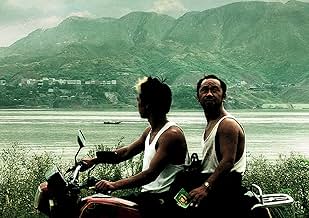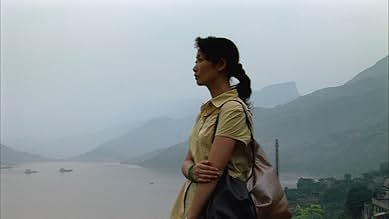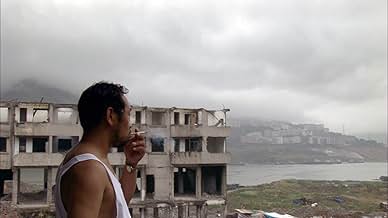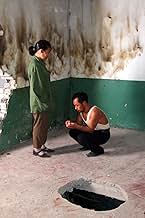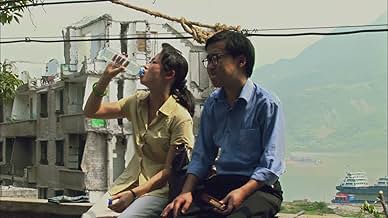CALIFICACIÓN DE IMDb
7.3/10
7.7 k
TU CALIFICACIÓN
Agrega una trama en tu idiomaA town in Fengjie county is gradually being demolished and flooded to make way for the Three Gorges Dam. A man and woman visit the town to locate their estranged spouses, and become witness ... Leer todoA town in Fengjie county is gradually being demolished and flooded to make way for the Three Gorges Dam. A man and woman visit the town to locate their estranged spouses, and become witness to the societal changes.A town in Fengjie county is gradually being demolished and flooded to make way for the Three Gorges Dam. A man and woman visit the town to locate their estranged spouses, and become witness to the societal changes.
- Dirección
- Guionistas
- Elenco
- Premios
- 15 premios ganados y 14 nominaciones en total
- Dirección
- Guionistas
- Todo el elenco y el equipo
- Producción, taquilla y más en IMDbPro
Opiniones destacadas
Still Life touches upon all the problems surrounding the controversial issue of the construction of the Three Gorges Dam but it only presents short glimpses of this reality, like colorful splashes of paint onto a palette: we see the young sixteen year old begging the outsider to take her away and find a job for her as a maid in a big city, panels indicating the phases of demolition, the word "demolition" painted outside people's residences, workers pulling down constructions, land compensation, relocation and myriads of hints at the inside stories of the people: helplessness, cynicism, acceptance, nostalgia.
The plot is very simple: a coal miner coming to the Three Gorges in search of his wife, whom he hasn't seen in sixteen years and a woman in search of her husband, whom she hasn't seen in three years. The human stories, set against the background of the Three Gorges and the Yangtze River, are fleeting, fragile, ethereal. The characters' journey is both physical and psychological. They both have traveled from Shanxi province in search of their wife and husband but their journey is also a journey into consciousness, nostalgia, loss and the past. Besides, it is also a crucial step before a new future. Along with the nostalgia and the lingering on what is lost, there is also a constant need to make decisions and move on, which is what the characters do. We, spectators, follow the characters at the same time as we/they make a journey into the Three Gorges. The connection between the characters and the landscape is obvious. The journey is not only into the characters' past but also a hint at the past of the Three Gorges, at all the villages which have been pulled down and at those who are about to disappear. The sense of loss in the characters' lives is unmistakably connected to the Three Gorges, to that which is already lost and to what is about to be taken away.
The film is definitely a beautiful and poetic reflection on time. The coal miner, Han Sanming, keeps the address of his former wife written on an old pack of cigarettes. When a young boy asks him what they are, he replies that they used to be the best brand of cigarettes sixteen years ago. The boy says he is too nostalgic, and to this, Han Sanming answers gravely that "we all remember our pasts". Yet Still Life is not only about time lost. There are also celebrations of the present. Han Sanming's determination to try again with his ex-wife is a note of optimism and hope. Various scenes in the film also show villagers dancing, enjoying a singing performance, where the camera lingers on their expressions of joy and enthusiasm, a clear celebration of life.
All the films I've seen about the Three Gorges and the Dam share a strong emphasis on the visual, arguably because the gripping power of the landscape cannot make it otherwise. Still Life is not an exception. One of its signs of distinction, which greatly accounts for the beauty of the film, is the way in which it is shot. The motion of the camera is always very slow and contemplative. It moves along the river banks as well as along objects and characters' faces in a fashion similar to that of a ship moving along the river. This slow, balanced, contemplative motion also recalls the movement of water, and brings to the viewer notions of fluidity, transformation and renewal. The background of the Three Gorges and the Yangzte is always there. Many takes show the contrast of the characters' insignificance against the overwhelming vastness of the landscape, and this is also done with objects. As Han Sanming contemplates a 10 Yuan note, the close take of the note is again set against the background of the Gorges. To all this must be added the attention to detail: the humanity of people's conversations, the taste of local Sichuan people, the colors, the contrasts. To me, Still Life is not only a cinematographic accomplishment. It is also evidence that people still remember, at this very important moment in time, the Three Gorges and its people.
The plot is very simple: a coal miner coming to the Three Gorges in search of his wife, whom he hasn't seen in sixteen years and a woman in search of her husband, whom she hasn't seen in three years. The human stories, set against the background of the Three Gorges and the Yangtze River, are fleeting, fragile, ethereal. The characters' journey is both physical and psychological. They both have traveled from Shanxi province in search of their wife and husband but their journey is also a journey into consciousness, nostalgia, loss and the past. Besides, it is also a crucial step before a new future. Along with the nostalgia and the lingering on what is lost, there is also a constant need to make decisions and move on, which is what the characters do. We, spectators, follow the characters at the same time as we/they make a journey into the Three Gorges. The connection between the characters and the landscape is obvious. The journey is not only into the characters' past but also a hint at the past of the Three Gorges, at all the villages which have been pulled down and at those who are about to disappear. The sense of loss in the characters' lives is unmistakably connected to the Three Gorges, to that which is already lost and to what is about to be taken away.
The film is definitely a beautiful and poetic reflection on time. The coal miner, Han Sanming, keeps the address of his former wife written on an old pack of cigarettes. When a young boy asks him what they are, he replies that they used to be the best brand of cigarettes sixteen years ago. The boy says he is too nostalgic, and to this, Han Sanming answers gravely that "we all remember our pasts". Yet Still Life is not only about time lost. There are also celebrations of the present. Han Sanming's determination to try again with his ex-wife is a note of optimism and hope. Various scenes in the film also show villagers dancing, enjoying a singing performance, where the camera lingers on their expressions of joy and enthusiasm, a clear celebration of life.
All the films I've seen about the Three Gorges and the Dam share a strong emphasis on the visual, arguably because the gripping power of the landscape cannot make it otherwise. Still Life is not an exception. One of its signs of distinction, which greatly accounts for the beauty of the film, is the way in which it is shot. The motion of the camera is always very slow and contemplative. It moves along the river banks as well as along objects and characters' faces in a fashion similar to that of a ship moving along the river. This slow, balanced, contemplative motion also recalls the movement of water, and brings to the viewer notions of fluidity, transformation and renewal. The background of the Three Gorges and the Yangzte is always there. Many takes show the contrast of the characters' insignificance against the overwhelming vastness of the landscape, and this is also done with objects. As Han Sanming contemplates a 10 Yuan note, the close take of the note is again set against the background of the Gorges. To all this must be added the attention to detail: the humanity of people's conversations, the taste of local Sichuan people, the colors, the contrasts. To me, Still Life is not only a cinematographic accomplishment. It is also evidence that people still remember, at this very important moment in time, the Three Gorges and its people.
Though perhaps 'Still Life'/'Sanxia haoren' (the Variety reviewer thought so) is primarily for the Jia devotee or the festival-goer (it's already been awarded the Golden Lion at Venice) and certainly it's totally noncommercial, it's a lovely, hypnotic piece of work, another haunting picture of the vast creation, disruption, destruction that is modern China from that country's most exciting and original younger-generation filmmaker.
There are layers of irony in the title, because in the incredibly turbulent, ceaselessly active events on screen in this world of life that is anything but "still," the most amazing images slip by without comment. A construction boss on a rampart one evening cell-phones a technician and says, "The VIP's are here. Why aren't the lights on? I'll count to three; then turn on. One, two, three. . ." and a huge bridge and arch are suddenly illuminated behind him. One of the two estranged couples the film follows to tentative reunions is talking with a vast city behind them and in the background a big skyscraper suddenly, silently collapses. There is no comment. It just miraculously happens. In the final shot, amid the debris of the Three Gorges where the world's largest dam will eventually displace 1.4 million people, Han Sanming (non-actor Han Sanming's actual name), a mine worker who's come to find his wife and daughter, who left him sixteen years ago, stands looking out at the urban landscape and a trapeze artist is quietly walking across a tightrope between tall buildings. Again, no comment.
Han Sanming can't find his wife right away and her brother doesn't trust him at first, so he stays for months, working with the brother in demolition. A perky young fellow, who quotes John Wu star Chow Yun Fat and imitates Hong Kong gangster gestures, befriends Han Sanming and they put each other's numbers in their cell phones--a contemporary pledge of solidarity that has a sad sequel later. The young fellow, who could easily have been one of the lost, hopeful young men in Jia's 2002 Unknown Pleasures, is lost in a demolition accident and gets a sea burial like the one accorded to Johnny Depp's character in Jim Jarmusch's Dead Man.
Focused on the displacement of people for a vast industrial and engineering project, Still Life also contrasts classes--the humble working-class stiff who can make 50 yuan a day pulling down walls or 200 going down in a coal mine not knowing if he'll come back out, versus the handsome lady, Shen Hong (Zhao Tao) whose estranged building magnate husband she wants to divorce because she's found a younger man. She has options; Han Sanming is simply drifting and lonely. And in the background for both, though, is the enormous turbulence and activity in which we see both protagonists as tiny helpless figures, their own lives indeed "still life" by comparison.
There's another unexpected, astonishing sequence of a fat rock singer, naked from the waist up like most of the Three Gorges demolition workers Han Sanming encounters and drenched in sweat. He sings of nostalgia for his youth, a time when everybody was happy , and old men in the audience shed tears while garish go-go girls gyrate: where does this fit in? This is another symbol of social upheaval. But what is really happening? Won't Chinese society have to return to its heritage of Mao and the Eighties aftermath chronicled in another of Jia's unwieldy masterpieces, the 2000 Platform? Perhaps the titles Still Life ironically points to the way people are frozen in isolation (broken couples, estranged children) and unhappiness (or quiet desperation) in a China that all the rampant economic progress both masks and perpetuates.
After his colorful land pointed but somewhat leaden 2004 The World/Shijie Jia Zhang-Ke has shown again as in Platform and Unknown Pleasures that he can touch and astonish. The human events are dwarfed by capitalist Progress in the new China, but people (after all, they are a zillion of them there) are still very much in the foreground. \Still Life is an impressive, organic-feeling movie that refers to Jia's earlier films but, extraordinarily, seems to bring together both post-war Italian neo-realism and the desolate urban landscapes of Michelangelo Antonioni.
Seen in Paris, October 21, 2007 at the MK2 Hautefeuille.
There are layers of irony in the title, because in the incredibly turbulent, ceaselessly active events on screen in this world of life that is anything but "still," the most amazing images slip by without comment. A construction boss on a rampart one evening cell-phones a technician and says, "The VIP's are here. Why aren't the lights on? I'll count to three; then turn on. One, two, three. . ." and a huge bridge and arch are suddenly illuminated behind him. One of the two estranged couples the film follows to tentative reunions is talking with a vast city behind them and in the background a big skyscraper suddenly, silently collapses. There is no comment. It just miraculously happens. In the final shot, amid the debris of the Three Gorges where the world's largest dam will eventually displace 1.4 million people, Han Sanming (non-actor Han Sanming's actual name), a mine worker who's come to find his wife and daughter, who left him sixteen years ago, stands looking out at the urban landscape and a trapeze artist is quietly walking across a tightrope between tall buildings. Again, no comment.
Han Sanming can't find his wife right away and her brother doesn't trust him at first, so he stays for months, working with the brother in demolition. A perky young fellow, who quotes John Wu star Chow Yun Fat and imitates Hong Kong gangster gestures, befriends Han Sanming and they put each other's numbers in their cell phones--a contemporary pledge of solidarity that has a sad sequel later. The young fellow, who could easily have been one of the lost, hopeful young men in Jia's 2002 Unknown Pleasures, is lost in a demolition accident and gets a sea burial like the one accorded to Johnny Depp's character in Jim Jarmusch's Dead Man.
Focused on the displacement of people for a vast industrial and engineering project, Still Life also contrasts classes--the humble working-class stiff who can make 50 yuan a day pulling down walls or 200 going down in a coal mine not knowing if he'll come back out, versus the handsome lady, Shen Hong (Zhao Tao) whose estranged building magnate husband she wants to divorce because she's found a younger man. She has options; Han Sanming is simply drifting and lonely. And in the background for both, though, is the enormous turbulence and activity in which we see both protagonists as tiny helpless figures, their own lives indeed "still life" by comparison.
There's another unexpected, astonishing sequence of a fat rock singer, naked from the waist up like most of the Three Gorges demolition workers Han Sanming encounters and drenched in sweat. He sings of nostalgia for his youth, a time when everybody was happy , and old men in the audience shed tears while garish go-go girls gyrate: where does this fit in? This is another symbol of social upheaval. But what is really happening? Won't Chinese society have to return to its heritage of Mao and the Eighties aftermath chronicled in another of Jia's unwieldy masterpieces, the 2000 Platform? Perhaps the titles Still Life ironically points to the way people are frozen in isolation (broken couples, estranged children) and unhappiness (or quiet desperation) in a China that all the rampant economic progress both masks and perpetuates.
After his colorful land pointed but somewhat leaden 2004 The World/Shijie Jia Zhang-Ke has shown again as in Platform and Unknown Pleasures that he can touch and astonish. The human events are dwarfed by capitalist Progress in the new China, but people (after all, they are a zillion of them there) are still very much in the foreground. \Still Life is an impressive, organic-feeling movie that refers to Jia's earlier films but, extraordinarily, seems to bring together both post-war Italian neo-realism and the desolate urban landscapes of Michelangelo Antonioni.
Seen in Paris, October 21, 2007 at the MK2 Hautefeuille.
The comment which was written before mine gives a great and brilliant explanation of the social problems and facts that involves this film, so I am not going to repeat it. I prefer to talk about another one of the most relevant aspects of this movie: the photography, magisterially directed by Yu Likwai. Sometimes one can have the impression to be watching a photo album, further than a movie. There are no bad or ugly photo-grams in this film. Every image contains a really fine sense of photography as an art, including superb landscapes, exiting colors, and intelligent compositions with everything and everybody in the right place, without unaesthetic gaps. A pleasure for eyes and soul.
Ancient towns have been submerged along the Yangtse River in China as part of the Three Gorges Dam project. Jia Zhang-Ke has created a contemplative and compassionate human drama set in the region, depicting two separate protagonists attempting to locate missing ones who lived in areas now underwater.
I'm not a great fan of high definition digital video photography, but this sublime film takes advantage of the benefits of the technology while avoiding most of the pitfalls. I was seriously sleep-deprived while watching the film and never got close to nodding off, even though there are very long takes where little seems to happen. Yet in takes, there are many passing details, the beautiful movements of camera taking in rich and authentic details of people, situations, implements, household paraphernalia and gorgeous sweeping vistas. The latter appeared to be enhanced using filters, which seemed to compensate for the loss of aesthetics that comes from not shooting on 35mm film. This film was visually beautiful, though that really only served what was an extremely well-made film.
As a lover of world cinema, I found the attention to detail fascinating. The director seemed to be sharing the idiosyncrasies of the local culture, customs and demeanour with a real sense of compassion and humanitarianism. I found it poetic, uplifting and moving. Paraphrasing Melbourne International Film Festival executive director Richard Moore's in introduction by quoting the director (who was in attendance as a guest of the festival): "I originally wanted to make films that would change the world... I now realise this is not possible, and I just wish to make films that make people sigh." It worked on me.
I'm not a great fan of high definition digital video photography, but this sublime film takes advantage of the benefits of the technology while avoiding most of the pitfalls. I was seriously sleep-deprived while watching the film and never got close to nodding off, even though there are very long takes where little seems to happen. Yet in takes, there are many passing details, the beautiful movements of camera taking in rich and authentic details of people, situations, implements, household paraphernalia and gorgeous sweeping vistas. The latter appeared to be enhanced using filters, which seemed to compensate for the loss of aesthetics that comes from not shooting on 35mm film. This film was visually beautiful, though that really only served what was an extremely well-made film.
As a lover of world cinema, I found the attention to detail fascinating. The director seemed to be sharing the idiosyncrasies of the local culture, customs and demeanour with a real sense of compassion and humanitarianism. I found it poetic, uplifting and moving. Paraphrasing Melbourne International Film Festival executive director Richard Moore's in introduction by quoting the director (who was in attendance as a guest of the festival): "I originally wanted to make films that would change the world... I now realise this is not possible, and I just wish to make films that make people sigh." It worked on me.
The movie tells two separate stories of two people. They are both from Shaanxi and take a long way to Fengjie to find their relatives. As they came to Fengjie, a 2000 year old city was going to submerge under water as the great Three Georges Dam was being built. Even though the media always tells great things about the Three Georges Dam, what the audience actually see is a dying town which is being demolished part by part. Along with the city is the destinies of poor people living here. People were forced to relocate and find another place to live and work. The movie is also very successful to depict the miserable living condition of poor people in the region. From here, another aspect of Chinese economic miracle is revealed as poor people find no way to get out of deadly spiral of poverty and have no choice but to move to other places such as Shaanxi to work as coal miners - a job as described in the movie can help them earn more money than their hometown but is also riskier as dozens of people die every year.
Another success of the film is the choice of music and songs that were played intermittently during the movie. In particular, the old song "Seung Hoi Tan" was used as a ringing tone for the phone of a local worker, perhaps as a reminder of old traditional value. On the other hand, "Mouse Love Rice" - a new rising love song at that time was singed passionately by the young kid marking the subtle transform in Chinese culture.
Another success of the film is the choice of music and songs that were played intermittently during the movie. In particular, the old song "Seung Hoi Tan" was used as a ringing tone for the phone of a local worker, perhaps as a reminder of old traditional value. On the other hand, "Mouse Love Rice" - a new rising love song at that time was singed passionately by the young kid marking the subtle transform in Chinese culture.
¿Sabías que…?
- TriviaRanked second in French film magazine Cahiers du cinéma's top 10 list of the best pictures of 2007, tied with El imperio (2006) and A prueba de muerte (2007).
- ConexionesFeatures Ying hung boon sik (1986)
Selecciones populares
Inicia sesión para calificar y agrega a la lista de videos para obtener recomendaciones personalizadas
- How long is Still Life?Con tecnología de Alexa
Detalles
Taquilla
- Presupuesto
- CNY 10,000,000 (estimado)
- Total en EE. UU. y Canadá
- USD 76,983
- Fin de semana de estreno en EE. UU. y Canadá
- USD 12,744
- 20 ene 2008
- Total a nivel mundial
- USD 2,504,465
- Tiempo de ejecución1 hora 51 minutos
- Color
- Mezcla de sonido
- Relación de aspecto
- 1.78 : 1
Contribuir a esta página
Sugiere una edición o agrega el contenido que falta

Principales brechas de datos
What is the French language plot outline for San xia hao ren (2006)?
Responda



